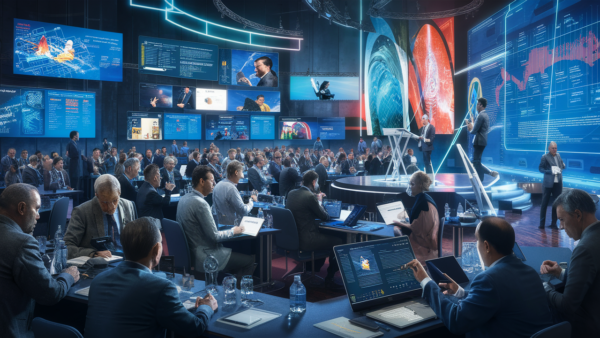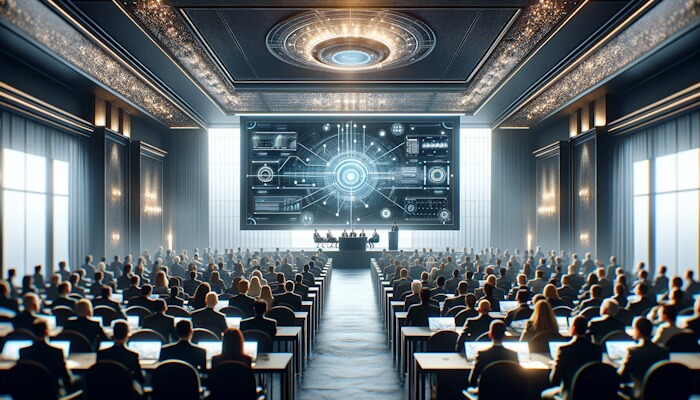AV system integration is the backbone of every successful event. That means you need seamless coordination of various audiovisual components – such as sound systems, projectors, screens, and lighting – to deliver a cohesive and impactful event.
It’s even more crucial for events or conferences hosting over 100 attendees, where effective AV integration ensures every participant can hear, see, and engage with content without distraction.
In this guidebook, we’ll explore the essential elements and best practices for achieving flawless AV system integration and providing attendees with an unforgettable experience.
Understanding Your Client’s Needs and Wants
Before you ever set up a light or speaker, it’s paramount to delve deep into understanding your client’s needs and wants.
Every event is unique and demands a tailored approach to AV system integration. Here’s how to ensure you’re meeting and exceeding client expectations:
- Venue Size and Layout: Assess the dimensions and layout of the venue to determine the optimal placement of audiovisual equipment for maximum coverage and impact.
- Audience Size and Composition: Consider the number of attendees and their demographics to ensure that the audiovisual setup accommodates everyone comfortably.
- Type of Event: Whether it’s a conference, seminar, product launch, or gala, the nature of the event dictates different AV requirements and setups.
- Desired Audiovisual Elements: Discuss with the client their vision for the event, including specific audiovisual elements such as projection mapping, LED walls and signage, or interactive displays.
- Budget Considerations: Work within the client’s budget constraints while still striving to deliver a high-quality AV experience that meets their needs.
With a keen understanding of your client’s requirements and what they want to accomplish, you can begin mapping out the equipment and setup you will need to achieve it.
Selecting the Right Equipment
Now that you know the venue and scope of the event, it’s time to carefully select the right equipment to bring your audiovisual vision to life. Each piece of equipment plays a vital role in delivering a seamless and immersive experience for attendees.
Make sure you have:
- Speakers: Consider the venue size and acoustics to determine the appropriate type and quantity of speakers needed for clear and balanced sound distribution.
- Microphones: Select microphones based on the presenter’s preferences and the event format. Whether it’s handheld, lapel, or podium microphones, the goal is to have crisp and intelligible audio.
- Projectors and Displays: Look at the venue’s lighting situation and audience sightlines to choose projectors and displays with the right brightness and resolution.
- Lighting Fixtures: Enhance the atmosphere and visual appeal of the event with strategic placement of lighting fixtures, including spotlights, wash lights, and LED fixtures, to create ambiance and highlight key elements.
- Control Systems: Use intuitive control systems that streamline the operation and management of AV equipment. For example, you can use Preseria to seamlessly organize and manage presentation content for a large number of speakers.
Of course, you want to prioritize equipment known for its quality, compatibility with other components, reliability in performance, and scalability to accommodate any enhancements or expansions needed. However, remember to stay within your client’s budget.

Designing and Configuring the AV System Layout
Alright, you know what the client needs, you know what equipment you’re going to use – now you need your blueprint. Designing and configuring the AV system layout means every piece and element needs to cohesively work together.
Start by mapping out the signal flow, so that audio and visual signals are routed efficiently from source to destination. This involves connecting the inputs and outputs of your devices such as mixers, amplifiers, projectors and displays in a logical and organized way.
Cable management is another important aspect you shouldn’t overlook. Organize cables in a way that minimizes clutter, reduces the risk of tripping hazards, and lowers the chance of signal interference. Speciality products such as AV cord tape is ideal for temporary fixing and holding wires and cables.
Also, you want a strategic approach to equipment placement throughout the venue. Take into account factors like sightlines, accessibility for maintenance, and proximity to outlets and other power sources.
Pay careful attention to room acoustics, which are affected by elements such as carpeting, the wall material, the shape of the venue, and a multitude of other factors.
Throughout the design and configuration process, functionality and ease of use are the top priority. That way, operators can navigate the AV system effortlessly during the event.
Testing Your AV System
Before the curtain rises, you need to thoroughly test all of your AV systems to uncover any potential glitches or hiccups that can throw off the entire event.
Rehearsals are great for this. They also provide an opportunity for operators to familiarize themselves with equipment, refine timing, and address any last-minute adjustments – so that’s a win-win.
Memorize (or bookmark) this checklist for your AV testing:
- Create a detailed testing checklist that covers all aspects of the AV system.
- Test the AV system under conditions similar to those expected during the event.
- Involve all relevant stakeholders, including event organizers, presenters, and technicians, in the testing process.
- Document any issues or adjustments made during testing.
- Conduct multiple rounds of testing.
- Simulate worst-case scenarios during testing – like power outages or equipment malfunctions – to assess the resilience of the AV system.
- Prepare backup plans for those potential issues.
- Perform final checks immediately before the event to ensure that all equipment is functioning.
Elevating Event Experiences with Seamless AV Integration
You’ve successfully integrated the AV system for your client and now it’s time for the event to start! With this guide, you can ensure the best possible experience for your client and their customers.
As you continue to refine your approach to AV system integration, remember the power of tools like Preseria. Our presentation management software simplifies the organization and management of multiple speakers and their content, ensuring smooth transitions and professional presentations.
Book your demo today to see Preseria in action and learn how it can revolutionize the way you do events. With the right tools in place, you’ll be ready to elevate event experiences to new heights!
